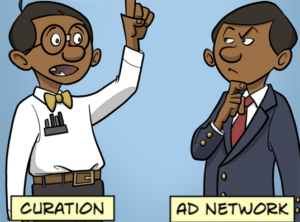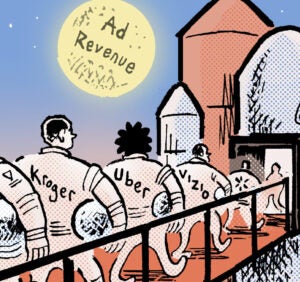 “Data-Driven Thinking” is written by members of the media community and contains fresh ideas on the digital revolution in media.
“Data-Driven Thinking” is written by members of the media community and contains fresh ideas on the digital revolution in media.
Today’s column is written by Scott Allan, chief marketing officer at AddThis.
Billions of dollars are being poured into content these days. Chief content officers are in demand, commanding six-figure salaries, while 71% of marketers plan to increase their content marketing budgets in 2014. BIA/Kelsey estimates that investments in native advertising will reach $5 billion by 2017, a startling forecast in a category hatched just a few years ago.
Everyone agrees that content is king. But will all the money flowing into content marketing help or hurt brands given the questionable value of what’s been published over the past decade?
The demand for fresh content and the need to fill the space left behind by laid-off journalists led to a deluge of contributed pieces that many consider far from insightful or unbiased. And since the material is optimized for keywords, the content continues to resurface long after its shelf life has expired. This makes it harder, not easier for customers to find the information they need.
That’s only one side effect. Don’t underestimate the hit your brand takes when a high-potential prospect reads what they believe is balanced information only to discover they’ve been duped into a sales pitch.
It will only get worse as more resources are allocated to native advertising and the pressure to create even more fresh content tempts ad purveyors to draw on old articles.
The pressure to produce volumes of optimized content isn’t new. For years, marketers have been cross-checking content against keyword lists and rewriting the rules of grammar in an attempt to appease search engine algorithms.
What is new, however, is the heightened demand for more content, largely driven by the rise of native advertising. This ups the ante for quality content across the board, but not every marketer has received the memo. Stale or just plain bad content won’t fill the native advertising hole. And without quality content, the content kingdom will collapse and native advertising will fail to reach its full potential.
In fairness, native ad platforms clearly label sponsored content per the American Society of Magazine Editors guidelines and have assigned professional editors to work with content marketers to ensure quality. Also, they’re not looking to dilute their brand by amassing pages of sponsored content.
Yet let’s not kid ourselves – native advertising is the newest revenue stream in the lucrative content creation market. It is one whose formula for success has been dictated by clicks more than quality.
Meanwhile, those without a flush native advertising budget will continue to get their messages out through contributed content. It’s a lower-cost alternative that doesn’t require contributors to specifically state when they have skin in the game. Many platforms make it easy to register and post content with little editorial oversight. Once the content goes live, the vendor behind it promotes the article on social networks, which allows unedited and unverified content to spread and resurface.
While there’s no cost to post content on those sites, it’s not free. Content agencies and so-called content strategists command a premium. Who among us hasn’t fallen into these traps, either as a consumer, creator or curator?
While we may grumble about those sites with a low threshold for accepting content – you know which ones I’m talking about – you can’t argue with the thousands, if not millions, of unique visitors they attract each month. This makes it even harder to convince content marketers that every self-serving article degrades the entire content ecosystem.
We can no longer allow this to happen, especially as consumers become savvier about what they’re reading and investors demand a return on native advertising dollars. Starting now, we must collectively create better content experiences.
As an industry, here’s what we can do.
- The native advertising ecosystem needs to set higher standards for content and resist the temptation for short-term profits at the expense of long-term success.
- Publishers should eliminate the “sign up and post” model and enforce more stringent guidelines for contributed content.
- CMOs need to champion increased investments in higher quality content. This includes establishing a long-term vision for editorial and saying no to publishing “good enough” content.
- Abandon the misguided belief that the sheer volume of content and the number of clicks and video completion rates are the only ways to stay relevant in search engines.
- Prioritize measuring engagement over traffic. Anybody can drive traffic but it’s quality content that keeps site visitors hooked.
Consumer behavior is the ultimate judge when it comes to content yet we shouldn’t risk our brand reputations with a spray-and-pray approach. If we continue to produce “meh” content, we’ll not only frustrate potential customers and compromise our brands, we’ll also diminish the value of marketing as a strategic function. Consumers on the hunt for quality content will create their own filters, much like they’ve done with Web banners and search results, and will potentially block out all contributed content.
The harder it is to find good content, the less valuable content marketing and native advertising becomes. Do we really want to put the responsibility of finding that content on our target audiences?
Follow AddThis (@addthis) and AdExchanger (@adexchanger) on Twitter.











